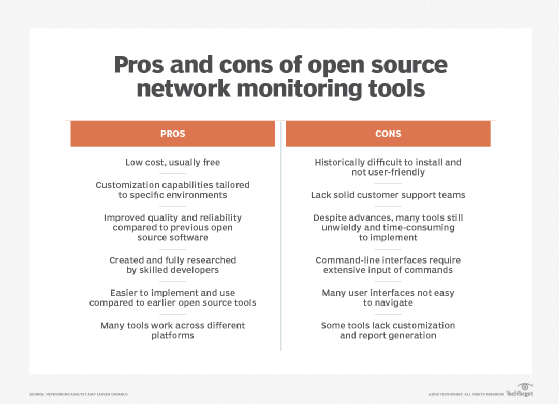
yblaz - Fotolia
What are the pros and cons of open source network monitoring tools?
They're usually free and customizable, but can lack customer support. Take a look at the best and worst features of open source network monitoring tools.
Open source network monitoring tools are increasingly attractive to IT groups trying to meet service-level agreement demands while operating under tight budgets that limit their ability to invest in sophisticated network monitoring services.
The price point for open source network monitoring software -- starting at free -- makes these tools pretty appealing for enterprises seeking new and better ways to manage performance across complex and highly distributed networks.
In the past, the knock on open source tools was that they were difficult to install and not user-friendly. And, unlike their commercial peers, open source network monitoring tools did not always have a strong customer support team that could help IT managers when they ran into problems.
However, open source network monitoring tools have progressed significantly in recent years. Some examples of open source network monitoring tools include OpenNMS, Icinga, Nagios, Observium, NetXMS, Zabbix, Zenoss Core and Sensu Core.
The benefits of open source network monitoring tools
More open source network monitoring tools include configuration wizards and web-based graphical user interfaces that make the services easier to implement and use.
Created by some of the industry's most skilled developers working together, the quality of open source network monitoring tools is considered on par or better than their more expensive commercial counterparts. Open source network monitoring tools, which undergo rigorous review by developers and users, are widely perceived as more reliable than the commercial tools.

Open source tools are also sometimes more customizable than the commercial options, allowing IT managers to tailor the software to incorporate rules specific to their environment. IT can take advantage of feature-rich open source network monitoring software that incorporates plugins and scripts to facilitate the monitoring of multiple flow protocols.
Many open source network monitoring tools are also cross-platform, and some allow for dashboard and report customization.
The drawbacks of open source network monitoring tools
While considerable advances have made open source network monitoring software easier to deploy and use, many tools are still kludgy and time-consuming to implement. Some tools that still use command-line interfaces require IT managers to input dozens of commands to configure the software. And many of the user interfaces are not easy to navigate.
Open source network monitoring tools offer better reports than in the past, but some don't allow for enough customization. In those cases, it can be difficult to export data to create external reports.
And, unlike their commercial counterparts, open source network monitoring tools don't typically come with an army of customer support specialists.








